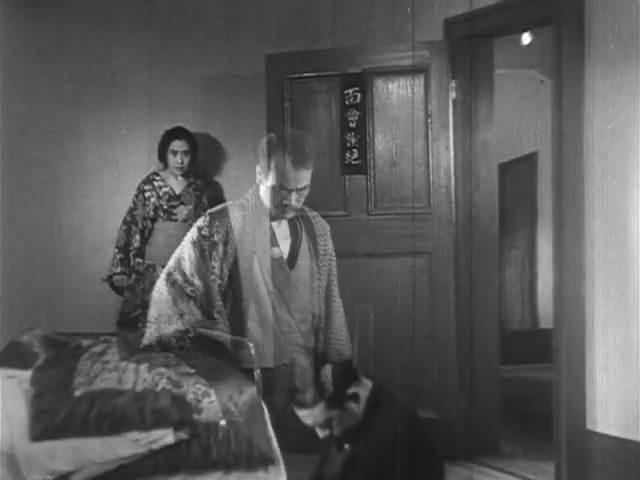Mizoguchi’s last silent film,* Osen offers a strange mix of sophistication and confusion.
Set in the pre-1900 era, the broad plot is simple — Osen finds a young man about to commit suicide. She prevents him and they are both taken in by a gang of some kind, but Osen breaks them free by ratting on the gang to the police and devotes her life to earning money to send him to medical school.

A moment of happiness as he studies
This eventually involves prostitution, though he is unaware of it, until she is arrested (wrongly) and they lose all contact. They are finally reunited when she collapses at a train station and he, now a doctor waiting for his own train, is called to treat her, but she is now insane and doesn’t recognize him. What is unclear about the movie are the details and motivation, especially a long central section in which the gang is somehow using her to steal a famous statue from a priest. The benshi normally would help with this, but for whatever reason, the available subtitles only cover about half of what the benshi says.
If, however, you are willing to sacrifice plot detail and just focus on the broad outlines and the techniques of the film maker, you will find some superb photography (by Minoru Miki, a Mizoguchi regular until the fifties) and a powerful, subtle, and varied performance from Isuzu Yamada, made all the more remarkable because she was apparently not quite 18 at the time of shooting but already demonstrating the dramatic authority of the finest silent screen actresses of any age in any country. That performance is unfortunately not matched by Daijiro Natsukawa, mostly whiny “poor me,” with the additional problems of being obviously far too old to be a student and wearing one of the worst male wigs in the history of film.**
As with so many Mizoguchi movies, there are some beautiful scenes.

Contemplating suicide
To my eye, at least, he had not yet become as mannered as he would be in many later features. Perhaps because he was still thinking silently, he actually has some closeups and medium shots used dramatically. And one surprising sequence can’t be shown in screen captures: When Osen is arrested, tucked in her kimono is an origami stork the boy has given her. With arms bound, she pulls it out with her mouth and blows it into the night air, where it seems to fly away like all her dreams. It is almost worth the whole movie to get to that sequence.
Most of the film is told in complex flashbacks, from both his and her point of view, though the time sequences of the flashbacks seem to be relatively sequential. Also unusual for Mizoguchi, there are some camera tricks, particularly Osen’s madness in the hospital which involves a number of double exposures of the men and incidents from her past.

The now insane Osen battles her past
Then there is also the origami bird. These, and Yamada’s performance, serve to separate Osen’s story from that of the thousands of other Japanese women who sacrifice their lives on film for a man.
- * Or perhaps not. The sound quality of the benshi and music tracks on the YouTube version suggest they were made in the thirties, so it is possible it was intended to be a “sound” film but without spoken dialogue. I have been unable to find any securely verifiable source, one way or another, on the question.
- ** This is of course not all that important, but it is nonetheless odd. The Japanese were (and still are) the world masters in wigs from the beginning of the film era, both male and female, due to the complex hair styles required in all period films, so why this Chia pet cap was thought satisfactory here is a real shock.